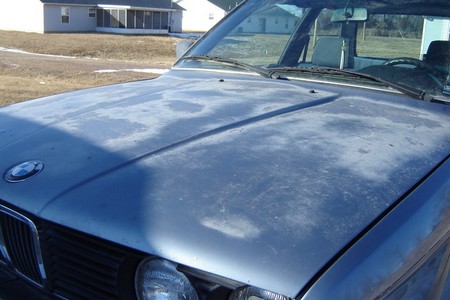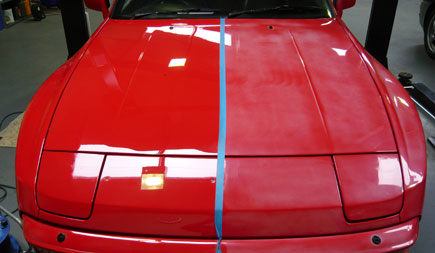The paint on a vehicle is affected by the ultraviolet rays of the sun. In time, paint fades, but this doesn’t mean that the car has to be repainted. Paint is applied to a vehicle in layers. Removing the top layer of faded paint exposes the like-new paint that lies beneath it. Several products are available for removing faded paint. Selecting the product that is best suited to the particular type of paint on your vehicle is of utmost importance. If you select the wrong product, you could rub off all the layers of paint, exposing the gray primer coat. You also have the option to bring your car to an auto paint correction shop for professional services.

Products fall into three categories: compounds, cleaner-waxes, and polishes.
Compounds and cleaner-waxes contain abrasives. Cleaner-wax has a minimum amount of abrasive, polishing compound (not to be confused with polish) has more, and rubbing compound has the most. Rubbing compound is used only when the paint on the vehicle is in such bad condition that if it fails to do the job, there is no alternative but to repaint the car.
Polish contains no abrasives. It possesses a cleaner that will remove dirt but not faded paint.
The first step in selecting a product is to identify the type of paint on the vehicle. There are three categories of paint. The following describes each type of paint, which product to use, and ways to use it.
Clearcoat/Basecoat Paint
Pigmented paint is used for the bottom coat. This is called the basecoat. The top coats of paint contain no pigment. They are transparent, which is why they are called the clearcoat. The clearcoat protects the basecoat from the sun’s rays and keeps it from getting dirty. In fact, just washing the vehicle, especially by hand, will remove dirt from the clearcoat to allow the luster of the basecoat to show through.
In time, however, the top layer of clearcoat can fade. Removing this layer will expose the layer beneath it.
Clearcoat layers are comparatively thin, so you must proceed with caution when dealing with basecoat/ciearcoat paint. When washing no longer produces a satisfactory result, first try to restore the luster of paint with a polish, which is nonabrasive and will not remove paint. If this fails to produce the desired effect, step up to a cleaner-wax, which is mildly abrasive, and then, if necessary, to a more abrasive polishing compound. Rubbing compound should not be used on a clearcoat/basecoat paint; it will rub right through the clearcoat layers.
Apply any product with a light hand. Don’t use heavy pressure or a machine. Doing so will cause all the clearcoat to be rubbed off.
Metallic Paint
Use a polish specifically formulated for metallic paint. Do not use an abrasive product.
Enamel or Lacquer Nonmetallic Paint
To restore the luster of a nonmetallic, nonbasecoat/clearcoat paint job, use polishing compound. If that proves unsatisfactory, use rubbing compound.
Whichever product you use—polish, cleaner-wax, or compound— the best result is attained by first hand-washing the vehicle. Try to do the job on a cloudy day. If this is not possible, park the car in shade.
Apply the product to one section at a time, the area of which should not exceed two square feet. Use a circular motion if the product is nonabrasive, a back-and-forth motion if it is abrasive. If an applicator is not provided with the product, use a terry-cloth rag. Read the manufacturer instructions on the container to find out whether the applicator should be damp or dry. Use clean terry-cloth rags to remove the product before it hardens. Then, buff the surface with another clean rag.
When applying an abrasive product near the edges of doors, fenders, hood, and trunk lid, use no pressure. Otherwise, you may rub off the paint, which is thinnest at these points.
The following measures will help you obtain satisfactory results when using an abrasive product:
- Cover moldings and hood ornaments with masking tape.
- To remove deep scratches in the paint that may be revealed after the faded paint has been removed, saturate a piece of 600- or 800-grit sandpaper with water and rub the scratch using light pressure. Then, wash the area with water from a garden hose.
- If the paint still appears dull after the initial treatment, more of the faded layer needs to be removed. Repeat the treatment.
- After the paint’s luster has been restored, wax the vehicle. Wax protects paint from the sun’s rays. It does not make the vehicle “shine.” Contrary to popular belief, applying more than one coat of wax is a waste of time. In applying a second coat, you will only rub off the first.









